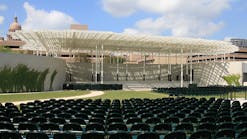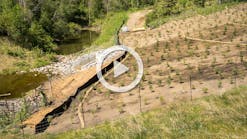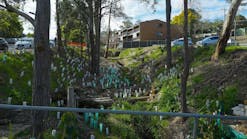The downchute conveys stormwater runoff from the Richmond Hill overburden stockpile.The first step in ACB installation is preparing the foundation. Site preparation is important to ensure adequate performance. The American Excelsior design manual states: ‘Before placing the Tri-lock system, the slope shall be inspected to insure that it is free from obstructions such as tree roots, projecting stones, or other foreign matter. Voids or other soft areas should be filled with suitable materials and well compacted. Although some variation in contour will be allowed, no sudden changes in level can be accepted’ (ErosionWorks 1996). This recommendation was adopted at Richmond Hill.Once the ground surface has been prepared, the geotextile filter fabric is placed. The lock-and-key blocks are transported to the site and manually placed in an interlocking fashion. Finally, the voids are partially backfilled with topsoil to permit vegetative growth. Extreme Events October 1994. On October 5, 1994, Richmond Hill experienced almost 7 inches of rainfall in less than 20 hours (LAC Minerals 2001). Heavy rainfall continued into October 6 but was not recorded because the storm caused a power failure at the site, disabling the rain gauge.May 1995. In May 1995, the property experienced an even higher intensity storm, when nearly 9 inches of rainfall were recorded within a 24-hour period (LAC Minerals 2001). This event nearly doubled the predicted 100-year design event.July 1997. On July 31, 1997, 2.04 inches of rain fell in 25 minutes. The design storm intensity used for the ACB downchutes for this duration storm is 1.4 inches of rain (LAC Minerals 2001). In addition, ‘This event was preceded by significant rainfall during the prior week, which increased antecedent moisture conditions. The structures performed extremely well and only minor repairs were required’ (Golder 1997).June 1998. On June 17 and 18, 1998, Richmond Hill experienced 6.97 inches of rain in approximately 20 hours (LAC Minerals 2001). During the storm, 2 inches of rain fell in less than one hour. CalculationsThe authors performed hydrologic modeling using the May 1995 storm event of 9 inches in 24 hours as a means to gauge the field conditions in the three downchute sections. Results are listed in Table 2.





